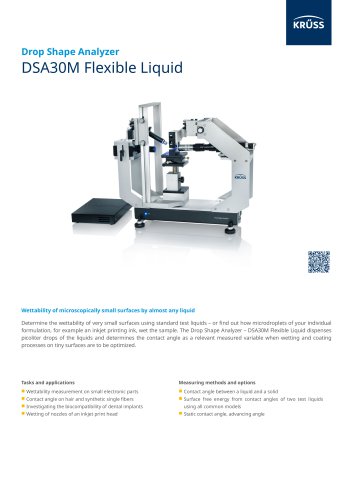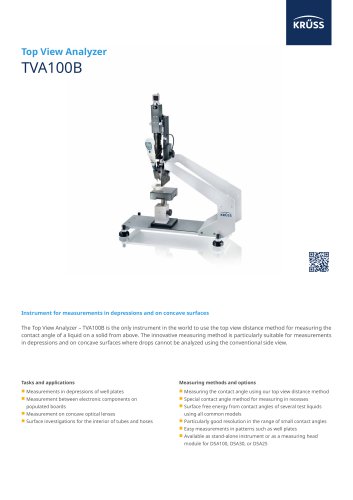 Website:
KRÜSS GmbH
Website:
KRÜSS GmbH
Group: Krüss
Catalog excerpts

Technical Note Technical note: Industry sections: Textiles, Paper, Coating, Surface Pretreatment Stefan Benn, Ming Jin, Frank Thomsen, Thomas Willers Methods: Keywords: Drop Shape Analyzer – DSA25 dosing, drop volume, contact angle, roll-off angle, falling drops, absorbing materials, paper Dosing falling drops with a defined volume for contact and roll-off angles Exact repeatability thanks to software-based generation of drops When it comes to measurements involving falling drops, the drop size and fall height have to be kept constant if comparable results are to be achieved. If the same needle diameter is used, falling drops of the same liquid are indeed always the same size. However, it is almost impossible to specify the volume or to dose different liquids with the same volume. In this Technical Note, we will present a method which can be used to generate drops with an exactly defined volume and purposefully detach them from the needle. Letting drops fall onto a sloping surface is therefore a common way of measuring the roll-off angle when analyzing self-cleaning surfaces, for example. Background information Although the falling drop measurement is not a standard method for the contact angle, there are some cases where using it makes sense. For highly absorbent materials, for example, the contact angle can often only be measured – in most cases with the help of a highspeed camera – by a drop falling onto the sample. Falling drops can also be used to simulate wetting in the rain. It is important to work with defined test parameters when dealing with such issues. Setting the fall height isn’t a technical challenge. Measurement with a defined volume causes greater difficulties. If dosing is carried out until the drop falls, then the volume is only constant if both the liquid and the needle diameter are the same. Apparently, the volume can be specifically adjusted only by making tiny changes to the needle diameter, so the time and effort involved is relatively large. Not only does this circumstance make it more difficult to vary the test parameters – for instance, when adding surfactants which reduce the surface tension – but it also reduces the repeatability of wetting tests involving falling drops. Method for dosing falling drops with a defined volume In our Applications & Science Center, we have developed a method to generate drops with an exactly defined KRÜSS GmbH | Borsteler Chaussee 85 | 22453 Hamburg | Germany | www.kruss
Open the catalog to page 1
volume and to make them fall onto the sample from the desired height. In doing so, we use a Drop Shape Analyzer - DSA25 with a software-controlled dosing system together with our ADVANCE software. By determining the magnification, which is easy to do, ADVANCE can calculate the volume of a drop from its video image. A new feature of the software also allows users to specify the volume of the drop generated on the dosing needle. Using a control loop, the piston position of the automatic syringe is corrected until the volume's actual value is identical to the target value. In a second step, we...
Open the catalog to page 2
Fig. 3: Volume examination of the same drop of water, respectively, one time as a pendant drop (PD) and time as sessile drop (SD) after the drop has fallen. Mean values for at least 10 drops are shown. The dosed liquid therefore reaches the sample entirely. The absolute difference between the actual value and the target value, and the spread of the volume measurement, tend to increase slightly as the volume increases. On the one hand, this could be related to the fact that, with the NE44 and NE62 steel needles, there was greater adhesion to the water than there was between water and the...
Open the catalog to page 3All KRÜSS GmbH catalogs and technical brochures
-
Product Overview 2025
84 Pages
-
DSA30M Flexible Liquid
2 Pages
-
Tensíío
2 Pages
-
Ayríís
2 Pages
-
FORCE TENSIOMETER – K20
2 Pages
-
FORCE TENSIOMETER – K6
1 Pages
-
TOP VIEW ANALYZER – TVA100B
2 Pages
-
DROP SHAPE ANALYZER – DSA30
2 Pages
-
DROP SHAPE ANALYZER – DSA30M
2 Pages
-
DROP SHAPE ANALYZER – DSA30R
2 Pages
-
Drop Shape Analyzer DSA25
2 Pages
-
DROP SHAPE ANALYZER – DSA100
2 Pages
-
Dynamic Foam Analyzer DFA100
2 Pages
-
DSA100, DSA30, EasyDrop
5 Pages
-
DSA100, DSA30
4 Pages
-
DSA100
3 Pages































